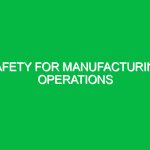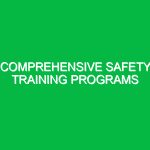Effective Safety Communication Techniques play a pivotal role in the Health, Safety, and Environment (HSE) domain. They not only bridge the gap between policy and practice but also create an environment where safety is prioritized and understood by all stakeholders. This article delves into the significance of these techniques, the risks associated with poor communication, actionable safety precautions, and the relevant regulations that govern effective communication in HSE settings.
Understanding Effective Safety Communication Techniques
Effective Safety Communication Techniques refer to the methods and strategies employed to convey safety-related information in a clear, concise, and accessible manner. These techniques encompass various forms of communication, including verbal, written, and visual methods. The relevance of these techniques cannot be overstated; they facilitate the dissemination of critical safety information, foster a culture of safety, and ultimately help to prevent accidents and incidents in the workplace.
In my experience working in the industrial sector, I’ve witnessed firsthand how effective communication can transform safety outcomes. For instance, during a routine safety briefing, a colleague shared a near-miss incident involving a malfunctioning machine. This wasn’t just a story; it served as a tangible reminder of the potential dangers we face daily. By sharing such experiences, we enhance our collective awareness and responsiveness to risks.
Identifying Hazards and Risks Associated with Poor Communication
While effective safety communication can mitigate risks, its absence can lead to several hazards. Common risks associated with poor communication in the HSE context include:
1. Misunderstanding of Safety Protocols
When safety protocols are not communicated clearly, employees may misinterpret or overlook critical steps in safety procedures. This misunderstanding can lead to accidents, injuries, or even fatalities. For example, in a chemical plant, if employees do not fully grasp the correct procedures for handling hazardous materials, the likelihood of spills or exposure increases dramatically.
2. Inadequate Training
Training sessions that fail to engage or address the specific needs of the workforce can leave employees ill-prepared to handle emergencies. A company I worked with once implemented a new safety software tool but neglected to provide adequate training. As a result, several employees were hesitant to use the system during an emergency, delaying critical responses.
3. Complacency and Neglect
Without regular reminders and updates, employees can become complacent about safety protocols. This is particularly evident in high-risk industries where routine tasks can lead to a false sense of security. For instance, a construction site might see workers neglecting to wear proper personal protective equipment (PPE) if safety reminders are not consistently communicated.
4. Ineffective Emergency Responses
In a crisis, clear communication is crucial. If employees are not familiar with emergency procedures, confusion can reign. During a fire drill at a manufacturing facility, clear instructions and designated roles made the difference between a smooth evacuation and a chaotic scene. In contrast, a lack of clarity can lead to panic and serious injuries.
Best Practices for Effective Safety Communication
To foster a culture of safety, organizations must adopt several best practices in their communication strategies:
1. Utilize Multiple Communication Channels
Different people absorb information in various ways. Therefore, employing a mix of verbal, written, and visual communication methods can enhance understanding. For example, consider using safety posters, digital signage, training videos, and regular safety meetings to reinforce key messages.
2. Simplify Language
Jargon and technical language can alienate employees, especially those who may not have extensive training. Aim for clear and simple language that everyone can understand. When discussing safety protocols, using accessible terminology ensures that all employees can comprehend and follow the guidelines.
3. Foster Two-Way Communication
Encourage feedback from employees regarding safety protocols and communication methods. This not only helps identify areas for improvement but also empowers employees to take an active role in safety. For instance, conducting regular safety audits with input from frontline workers can unveil gaps in communication that management may overlook.
4. Regularly Update Safety Information
Safety guidelines and protocols can evolve based on new regulations or operational changes. Keeping all safety information up-to-date is vital. Implement a systematic approach for reviewing and updating safety communications regularly, such as quarterly safety meetings that revisit existing protocols and introduce new ones.
5. Lead by Example
Management must exemplify the safety culture they wish to instill. When leaders prioritize safety in their communications and actions, employees are more likely to follow suit. For instance, if supervisors consistently wear PPE and adhere to safety protocols, it sets a standard for the entire team.
Safety Precautions and Actionable Advice
While the best practices outlined above can significantly enhance safety communication, specific precautions should also be taken to address potential hazards:
1. Conduct Regular Training Sessions
Training should not be a one-time event. Schedule regular refreshers and include hands-on practice to reinforce learning. A construction company I collaborated with adopted a monthly training schedule that included real-life scenario simulations, which significantly improved employee preparedness.
2. Create a Safety Communication Plan
A well-structured communication plan can help streamline safety messages. This should include the identification of key safety personnel, methods for disseminating information, and a schedule for regular updates. Having a clear plan ensures that safety communication is consistent and effective.
3. Use Technology to Enhance Communication
Leveraging technology can greatly improve communication efficiency. Consider adopting tools like mobile apps that provide real-time safety updates, incident reporting, and access to safety resources. These tools can facilitate immediate communication and ensure that employees are always informed.
4. Encourage Reporting and Accountability
Fostering a culture where employees feel comfortable reporting safety concerns or near misses is vital. Implement an anonymous reporting system to encourage openness. When employees know their concerns will be addressed, they are more likely to participate in the safety conversation.
Regulations and Standards Governing Safety Communication
Several regulations and standards govern safety communication in the workplace. Understanding these frameworks is essential for compliance and effective safety communication:
1. Occupational Safety and Health Administration (OSHA)
OSHA sets forth regulations mandating employers to communicate hazards effectively. This includes providing training, safety data sheets (SDS), and clear labeling of hazardous materials. Employers must ensure that employees are aware of the risks associated with their jobs and how to mitigate them.
2. ANSI Z535 Standards
The American National Standards Institute (ANSI) has established the Z535 series of standards that provide guidelines for the design and use of safety signs and symbols. Adhering to these standards can enhance the effectiveness of visual communication in conveying safety messages.
3. ISO 45001
The ISO 45001 standard focuses on occupational health and safety management systems. It emphasizes the importance of effective communication within safety management frameworks, highlighting the need for clear and open dialogue regarding safety risks and procedures.
Conclusion
Effective Safety Communication Techniques are crucial in fostering a safe working environment across various industries. By addressing potential hazards, implementing best practices, and adhering to relevant regulations, organizations can significantly reduce risks and enhance employee safety. As we have explored, the importance of clear communication cannot be overstated; it is not merely a procedural formality but a vital component of a successful safety culture. Investing in these techniques ultimately pays dividends, ensuring that safety is ingrained in every aspect of the workplace.


